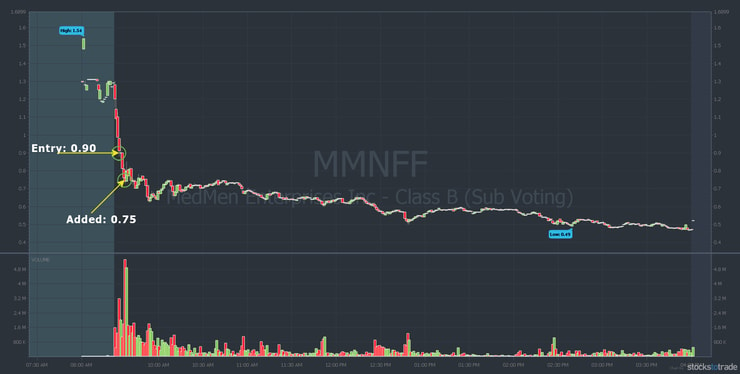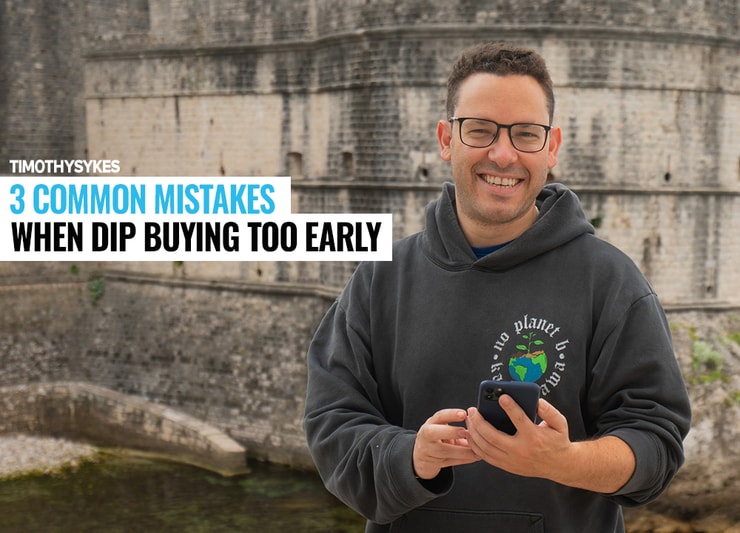3 Common Mistakes Dip Buying Too Early: Key Takeaways
- You MUST keep things in perspective or risk a muddled mindset.
- Why promoters try to create a ‘soft landing.’ (And how THAT creates a predictable pattern.)
- Which common mistake did Jack Kellogg make on his biggest-ever loss? Keep reading…
Be sure to read “How To Spot the Top of a Penny Stock Pump.” It explains a new way I’ve found to identify topping action. I used Ilustrato Pictures International, Inc. (OTCPK: ILUS) as an example of how it works.
In this post, I’ll review my bungled ILUS trade and explain three common mistakes dip buyers make. First, let’s review…
Table of Contents
Why Promoted Stocks Crash and Bounce

Promoted stocks crash because they’re promoted.
Promoters accumulate shares before or during the promotion. Sometimes they’re paid with shares, and sometimes they buy shares ahead of time. When they stop promoting and start selling … it’s like a jet without fuel.
Why do promoted stocks bounce? The promoters need to create a soft landing so they don’t get investigated. That’s why I like promoted stocks. They have predictable panics and bounces.
That said, you don’t know exactly how soft a landing the promoters will create. Sometimes they try to repump to create a soft landing but it doesn’t work. And that leads to common mistakes.
Do You Make These Mistakes Dip Buying Too Early?
The first mistake below is the one I didn’t make on ILUS. Take heed, because it can be very costly…
Dip Buying Too Early Mistake #1: Adding to a Loser
I have nearly two dozen millionaire students now.* If you look at the trades of the top ones, one of the biggest mistakes they made is adding on dip buys that don’t bounce.
A great example is Jack Kellogg’s MadMen Enterprises, Inc. (OTCQX: MMNFF) trade from February 11, 2021. Based on the setup, you couldn’t argue with Jack’s thesis. MMNFF was a multi-day runner that was up big, and it was finally cracking.
Jack entered early, which is dangerous enough on a dip buy. Believing you’re right and adding only compounds the mistake. As the stock continued to drop, he averaged down. I don’t know the details of all Jack’s entries and exits. This chart shows his first two entries…

Jack tried to scale into a losing position, trading a total of 2.4 million shares of MMNFF that day. When it didn’t bounce, he was forced to close his positions for a 20%, $367,024 loss.
Before I move on to the second common mistake when dip-buying too early, it’s only fair to…
Put Jack’s Trade in Perspective
While Jack’s loss seems massive, the same day he closed a swing trade for an 893% win and $132,111 in profits.* (Jack’s stake in that trade was $14,835.) It was also his biggest week ever with total profits of $1,373,264.* To put that in perspective, it’s more than I’ve made in all of 2021 so far.
Jack prepared for the hottest market in decades and pushed it harder than anyone I know.
Just be aware that adding to a loser is dangerous. Jack already knew that but he’ll never forget the trade. Sometimes it takes the pain of a big loss to burn a rule into your brain.
Back to ILUS…
Dip Buying Too Early Mistake #2: Wanting It Too Badly

After ILUS promoters came out of the blue to attack me on social media, I was prepared. And even though I captured the morning panic, I got faked out on the bigger panic. This brings up an interesting, counterintuitive part of trading…
I was so prepared it led me to enter early, opening me up to losses. That’s why I say it’s good to…
Be a Retired Trader
Say to yourself, “I don’t need to trade.”
Part of the reason I keep busy is because it prevents me from overtrading. I know these patterns so well it’s almost, “Let me trade, let me trade…” Like a kid saying, “Put me in coach, put me in.”
That kind of hunger, obsession, and addiction is dangerous to traders. Even though I know the patterns, there are fakeouts sometimes. I prefer to get called away from my busy life to come back to the markets when a trade is so good I’d feel guilty missing it.
Because of how much the stock was up, and the number of promoters, I entered on the first green candle. I thought it was the bottom. Then I cut losses into the big drop, which turned out to be the real bottom.

My being so prepared made me want it that much more. After cutting for a loss, I watched it turn. Then my head was all screwed up because I jumped the gun.
Some people reading this will ask, “Why not just hold until it hits the bottom and ride it back up?”
Refer to rule #1: cut losses quickly. Panics don’t always bounce. Remember Jack’s MMNFF trade above. It’s better to cut losses and walk away. Hold and hope is not a strategy.
To Buy or Not to Buy the First Green Candle?
That is the question…
Sometimes if you don’t buy the first green candle, you miss out. So I’m not saying don’t buy the first green candle. But be aware of your mindset and don’t fall for the next common mistake…
Dip Buying Too Early Mistake #3: Forgetting Other Indicators
Trading isn’t an exact science. Over the years I’ve developed a checklist of indicators. After 20 years of trading, it’s a mental exercise rather than something I write down.
But sometimes, if you want it too badly, you lose perspective.
I should have been aware of my mindset. And I should’ve thought everything through. ILUS was choppy. And even though it fell off a cliff from $0.31 to $0.29, that’s only a 6.5% drop. That’s not really enough. I should have been more patient.
When you get faked out like I did with ILUS, you start thinking…
“Wait, I might be a little off. Do I really know these patterns?”
And THAT affected my next trade on Cyberlux Corp. (OTCPK: CYBL). It was a $266 win, but it coulda, shoulda, woulda been much bigger.* My head was all screwed up because of ILUS and I missed out.
The Importance of Reviewing Trades

I’m not very proud of the wasted opportunity on ILUS and CYBL. The important thing is to learn from every trade. Figure out what you can do better in the future. Be honest with yourself. And be transparent by posting your trades on Profit.ly.
However you do it, review every trade. Profitable traders get that way by testing, tweaking, and reviewing data.
Trading Challenge
This post scratches the surface of what you should know about dip buying promoted stocks. All my top students refined their trading skills in the Trading Challenge. If you want to learn the nuances and hone your skills, apply for the Trading Challenge today.
What do you think of the 3 common mistakes when dip buying too early? Comment below, I love to hear from all my readers!
Disclaimers
*Results are not typical and will vary from person to person. Making money trading stocks takes time, dedication, and hard work. Most who receive free or paid content will make little or no money because they will not apply the skills being taught. Any results displayed are exceptional. We do not guarantee any outcome regarding your earnings or income as the factors that impact such results are numerous and uncontrollable.
It takes years of dedication, hard work, and discipline to learn how to trade. Individual results will vary. Trading is inherently risky. Before making any trades, remember to do your due diligence and never risk more than you can afford to lose. I’ve also hired Jack Kellogg to assist in my education business.





Leave a reply